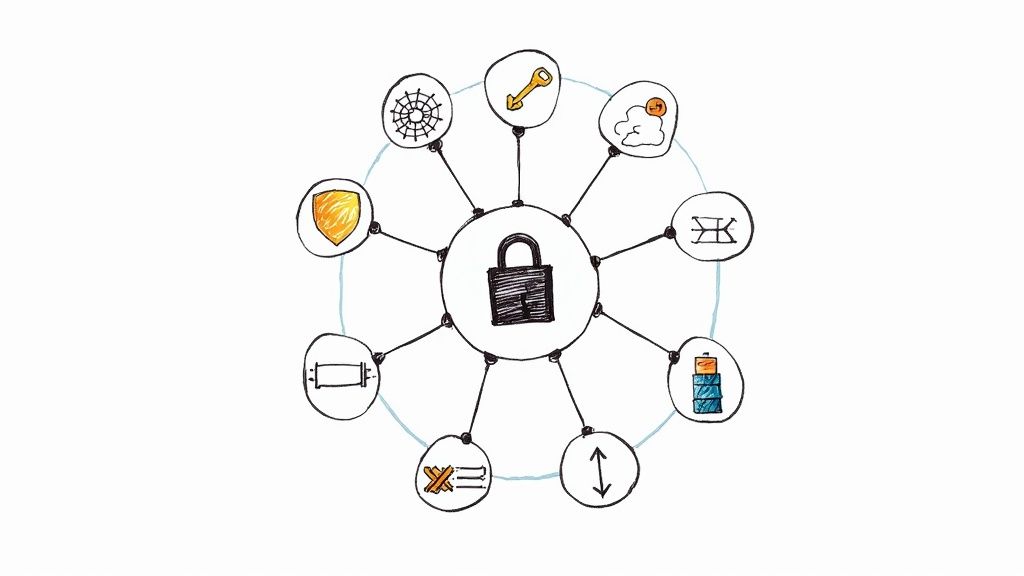
Act I: The Setup - Why We Need Encryption
Picture this: You're Ethan Hunt from Mission Impossible, and you need to send classified information across enemy territory. One wrong move, and your message falls into the wrong hands. This is exactly why we need encryption – it's our digital disguise, our cyber invisibility cloak.
In the world of cybersecurity, we have two main protagonists in our encryption thriller: Symmetric Keys and Asymmetric Keys. Think of them as two different approaches to the same mission – keeping secrets safe.
Act II: The Symmetric Key - "Ocean's Eleven" Style
What is Symmetric Encryption?
Imagine Danny Ocean's crew from Ocean's Eleven. They all share the same master key to the vault – one key that both locks and unlocks everything. That's symmetric encryption in a nutshell.
In symmetric encryption:
- One key rules them all – The same key encrypts and decrypts data
- Lightning fast – Like Vin Diesel in Fast & Furious, it's all about speed
- The trust factor – Both parties must securely share the key beforehand
The Symmetric Encryption Process
Here's how our Ocean's Eleven scenario plays out:
Popular Symmetric Algorithms
- AES (Advanced Encryption Standard) – The Tony Stark of encryption, sophisticated and reliable
- DES (Data Encryption Standard) – The classic James Bond, older but still respected
- 3DES (Triple DES) – DES with a trilogy twist, like The Matrix series
The Symmetric Key Dilemma
But here's the plot twist worthy of a Christopher Nolan film: How do you securely share that master key in the first place? It's like trying to send Danny Ocean the vault combination through a room full of Benedict's security guards.
Act III: The Asymmetric Key - "The Departed" Double Identity
What is Asymmetric Encryption?
Now imagine "The Departed" scenario – Leonardo DiCaprio and Matt Damon have different identities for different purposes. Asymmetric encryption works similarly with a public key (your open identity) and a private key (your secret identity).
The Magic of Public-Private Key Pairs
Think of it like this:
- Public Key = Your mailing address (everyone can know it)
- Private Key = Your house key (only you should have it)
Digital Signatures: The Plot Twist
But wait, there's more! Asymmetric encryption also enables digital signatures – think of it as the "Inception" of cryptography, where the roles reverse:
- Sign with private key – Only you can create your signature
- Verify with public key – Anyone can verify it's really from you
Popular Asymmetric Algorithms
- RSA – The Godfather of public-key cryptography, classic and powerful
- ECC (Elliptic Curve Cryptography) – The John Wick of encryption, smaller but incredibly effective
- Diffie-Hellman – The masterminds behind key exchange, like the architects in Inception
Act IV: The Showdown - Symmetric vs Asymmetric
Let's break down this epic face-off:
Performance: The Need for Speed
| Aspect | Symmetric | Asymmetric |
|---|---|---|
| Speed | Fast & Furious ⚡ | More like a careful heist 🐌 |
| Resource Usage | Lightweight champion | Resource intensive |
| Data Size | Perfect for large files | Better for small data |
Security: The Trust Factor
Symmetric Encryption:
- Pros: Like a bank vault – incredibly secure if you have the key
- Cons: Key distribution is the Achilles' heel
Asymmetric Encryption:
- Pros: No need to share secrets beforehand – it's like magic!
- Cons: More complex, slower, and computationally expensive
The Real-World Plot Twist: Hybrid Approach
Here's where it gets interesting – most real-world applications use both, like a perfectly orchestrated heist movie!
This hybrid approach gives us:
- The security of asymmetric encryption for key exchange
- The speed of symmetric encryption for data transfer
Act V: Real-World Applications
HTTPS: Your Daily Digital Bodyguard
When you visit a website with HTTPS:
- Asymmetric handshake – Like the opening scene where agents exchange briefcases
- Symmetric session – The actual secure conversation, fast and efficient
Banking: The Ultimate Heist Prevention
Banks use this dual approach:
- Asymmetric for initial authentication (proving you are who you say you are)
- Symmetric for transaction data (keeping your money movements secret)
Messaging Apps: Your Personal Encryption Agents
Apps like WhatsApp and Signal use:
- Asymmetric encryption for key exchange
- Symmetric encryption for message content
The Final Credits: Choosing Your Encryption Adventure
When planning your own digital security strategy:
Choose Symmetric when:
- You need blazing fast performance
- You're encrypting large amounts of data
- You have a secure way to share keys
Choose Asymmetric when:
- You need to communicate with strangers securely
- Digital signatures are important
- Key distribution is a challenge
Choose Hybrid when:
- You want the best of both worlds (most common in practice)
Epilogue: The Future of Encryption
As we stand on the brink of quantum computing (think "Interstellar" level of mind-bending), both symmetric and asymmetric encryption face new challenges. Quantum computers could potentially break current asymmetric algorithms, leading to the development of quantum-resistant cryptography – but that's a sequel for another day!
Remember, in the world of cybersecurity, you're not just a user – you're the protagonist in your own digital thriller. Choose your encryption wisely, and may your keys always stay secure!
"In encryption we trust, but verify with mathematics." – Every cybersecurity professional, probably
Want to dive deeper? Start experimenting with cryptographic libraries in your favorite programming language, and remember: with great encryption power comes great responsibility!
Become a subscriber receive the latest updates in your inbox.






Member discussion